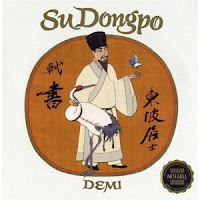Two idiomatic phrases in the Chinese culture and in the west, respectively, yoke together images and words. Chinese scholar-painters, hewing to high-minded literary ideals, liked to think of their artistic practice as "writing pictures." Thus, their paintings would be infused with poetic and calligraphic sensibility. In the west, the phrase "a picture paints a thousand words" suggests how a single image can capture and convey in an instant a human saga. Pictures have a way of reaching across cultures and generations. Here are three books that deal, in different ways, with painting and childhood.
What I liked best about
Peter's Painting was that Peter's ethnicity (signaled by facial features, hair texture, etc.) was purely incidental. Peter is an everychild, who channels his creativity into paintings of a bird that flies, a snake that slithers, and a fish that swims. Finally, Peter paints a door that opens into—you guessed it—the colorful world that Peter created. The text is simple and repetitive (think Eric Carle's
Brown Bear, Brown Bear). And while the text and illustrations aren't the most memorable, it is refreshing to have a book in which a child with Asian features is treated just like anyone, and everyone else.
Before emigrating to Canada (following the Tiananmen tragedy of 1989), Song Nan Zhang experienced the ups and downs of life under Communism in the People's Republic of China, and eventually attained a professorial post in Beijing. Zhang channels his life, his optimism, and his talent into
The C
hildren of China: An Artist's Journey, which is one part autobiography, one part children's coffee-table book, and one part illustrated ethnography. Each of these parts is compelling in its own way: Zhang's story is inspiring and hopeful, the book is filled with his colorful and sensitive paintings of children, and the children hail from many ethnicities that make up the PRC, including Tibetans, Mongolians, Kazakhs, Uygurs, and Yi. The map at the book's beginning helps us to locate the paintings geographically, and I like how easily the book replaces a mono-ethnic view of China. But because the book doesn't fit easily into any particular genre, presenting it to your children may be a challenge. It might be better consumed as a coffee table book, in a leisurely, non-linear fashion, and certainly it would be great in a classroom setting.
Zheng Zhensun and Alice Low's book about Wang Yani,
A Young Painter, discusses the life and work of a talented girl from toddler-hood to early adolescence. The book is filled with photographs of Yani at work and at play, and lots of her paintings. The ones of mischievous monkeys are absolutely delightful. The book is substantial non-fiction (80 pages, including appendix, glossary, map, and index), and is thus especially rewarding for art enthusiasts. But, the many colorful paintings would be wonderful inspiration
to wider audiences old and young.
Sally Moss (author) Meredith Thomas (illustrator)
Peter's Painting
Mondo, 1995
Song Nan Zhang
The Children of China: An Artist's Journey
Tundra Books, 1995
Zheng Zhensun and Alice Low (authors)
A Young Painter: The Life and Paintings of Wang Yani—China's Extraordinary Young Artist
Scholastic, 1991










































